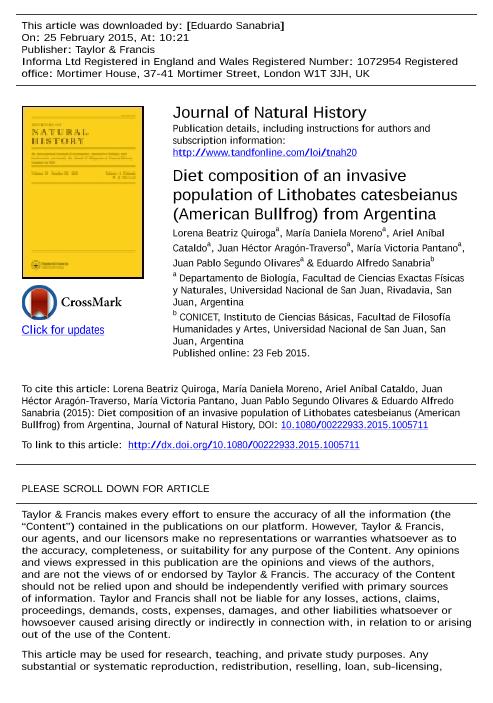Artículo
Diet composition of an invasive population of Lithobates catesbeianus (American Bullfrog) from Argentina
Quiroga, Lorena Beatriz ; Moreno Avila, María Daniela; Cataldo, Ariel Anibal; Aragon y Traverso, Juan Héctor
; Moreno Avila, María Daniela; Cataldo, Ariel Anibal; Aragon y Traverso, Juan Héctor ; Pantano, María Victoria; Olivares Toselli, Juan Pablo Segundo; Sanabria, Eduardo Alfredo
; Pantano, María Victoria; Olivares Toselli, Juan Pablo Segundo; Sanabria, Eduardo Alfredo
 ; Moreno Avila, María Daniela; Cataldo, Ariel Anibal; Aragon y Traverso, Juan Héctor
; Moreno Avila, María Daniela; Cataldo, Ariel Anibal; Aragon y Traverso, Juan Héctor ; Pantano, María Victoria; Olivares Toselli, Juan Pablo Segundo; Sanabria, Eduardo Alfredo
; Pantano, María Victoria; Olivares Toselli, Juan Pablo Segundo; Sanabria, Eduardo Alfredo
Fecha de publicación:
02/2015
Editorial:
Taylor & Francis Ltd
Revista:
Journal of Natural History
ISSN:
0022-2933
Idioma:
Inglés
Tipo de recurso:
Artículo publicado
Clasificación temática:
Resumen
The American bullfrog Lithobates catesbeianus has been introduced around the world, with invasive populations reported from almost all South American countries. A population of this species was introduced in the Calingasta department of San Juan province, which is an arid environment in western Argentina. This work provides information on the dietary composition of an invasive population of L. catesbeianus, and compares the degree of dietary overlap between adults and juveniles. Stomach contents of 169 bullfrogs (82 adults and 87 juveniles) were analysed. Adults consumed 40 prey taxa and Hymenoptera (Insecta) was the most numerous prey item (41.8%), followed by Araneae (13.6%) and Aeglidae (13.4%). Juveniles consumed 29 prey taxa and Hymenoptera constituted the highest percentage in prey number (77.2%). The trophic overlap niche index at the same level shows a value of 0.64 overlap in dietary community between adults and juveniles of this bullfrog. Aeglidae was volumetrically the most important trophic item (25.4%), followed by Anura (25.02%). Our results showed that cannibalism in bullfrogs is more common than the consumption of native anurans, coinciding with that reported in other populations of introduced bullfrogs. The high similarity in the diets of both size classes and the association between the size of the predator and prey suggest that the impact caused by bullfrogs throughout their ontogeny is high andprobablyhasanimpactontheirprey.Freshwatercrabsarethemainitemsinthe diet of Lithobates catesbeianus in other introduced populations and are usually the most conspicuous at our study site. The crabs in freshwater ecosystems are part of the lowest trophic level in the food chain. The major threats to the southern region’s freshwater crabs include deforestation, farming and exotic species. Lithobates catesbeianus has a generalist diet and high overlap between adults and juveniles.
Palabras clave:
AMERICAN BULLFROG
,
AMPHIBIAN
,
INVASIVE POPULATION
,
LITHOBATES
,
ARGENTINA
Archivos asociados
Licencia
Identificadores
Colecciones
Articulos(CCT - SAN JUAN)
Articulos de CENTRO CIENTIFICO TECNOLOGICO CONICET - SAN JUAN
Articulos de CENTRO CIENTIFICO TECNOLOGICO CONICET - SAN JUAN
Citación
Quiroga, Lorena Beatriz; Moreno Avila, María Daniela; Cataldo, Ariel Anibal; Aragon y Traverso, Juan Héctor; Pantano, María Victoria; et al.; Diet composition of an invasive population of Lithobates catesbeianus (American Bullfrog) from Argentina; Taylor & Francis Ltd; Journal of Natural History; 49; 27-28; 2-2015; 1703-1716
Compartir
Altmétricas



